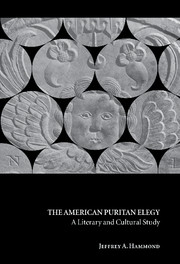Book contents
- Frontmatter
- Contents
- Preface
- Acknowledgments
- Introduction
- Chapter 1 Monuments enduring and otherwise
- Chapter 2 Toward an anthropology of Puritan reading
- Chapter 3 Weep for yourselves: the Puritan theology of mourning
- Chapter 4 This potent fence: the holy sin of grief
- Chapter 5 Lord, is it I?: Christic saints and apostolic mourners
- Chapter 6 Diffusing all by pattern: the reading of saintly lives
- Epilogue: Aestheticizing loss
- Notes
- Works cited
- Index
Epilogue: Aestheticizing loss
Published online by Cambridge University Press: 22 September 2009
- Frontmatter
- Contents
- Preface
- Acknowledgments
- Introduction
- Chapter 1 Monuments enduring and otherwise
- Chapter 2 Toward an anthropology of Puritan reading
- Chapter 3 Weep for yourselves: the Puritan theology of mourning
- Chapter 4 This potent fence: the holy sin of grief
- Chapter 5 Lord, is it I?: Christic saints and apostolic mourners
- Chapter 6 Diffusing all by pattern: the reading of saintly lives
- Epilogue: Aestheticizing loss
- Notes
- Works cited
- Index
Summary
The summer of 1708 saw the passing of Ezekiel Cheever, the ninety-four year old headmaster at Boston Latin. Cotton Mather, Cheever's most prominent former student, undertook the duty of embalming this “Christian Terence” with thanks for what Cheever had given to his “Almighty Tribe of Well-instructed Youth”:
All the Eight parts of Speech he taught to them
They now Employ to Trumpet his Esteem.
They fill Fames Trumpet, and they spread a Fame
To last till the Last Trumpet drown the same. (Verse 88)
Cheever's Latin Accidence: An Elementary Grammar had become the standard text in New England, and Mather found it appropriate to mourn his old teacher in elaborate figures recalling the subject he had taught for seven decades. Nor was Mather the only poet to do so. Another tribute, entitled “The Grammarian's Funeral,” made Mather's application of wit seem positively restrained. Benjamin Tompson, who had actually written the elegy four decades earlier at the death of another schoolmaster, published it in broadside at Cheever's death. The poem was unusual, to say the least. Instead of the usual celebration of faith, Tompson centers an impressive display of poetic ingenuity around Cheever's calling.
- Type
- Chapter
- Information
- The American Puritan ElegyA Literary and Cultural Study, pp. 205 - 210Publisher: Cambridge University PressPrint publication year: 2000

